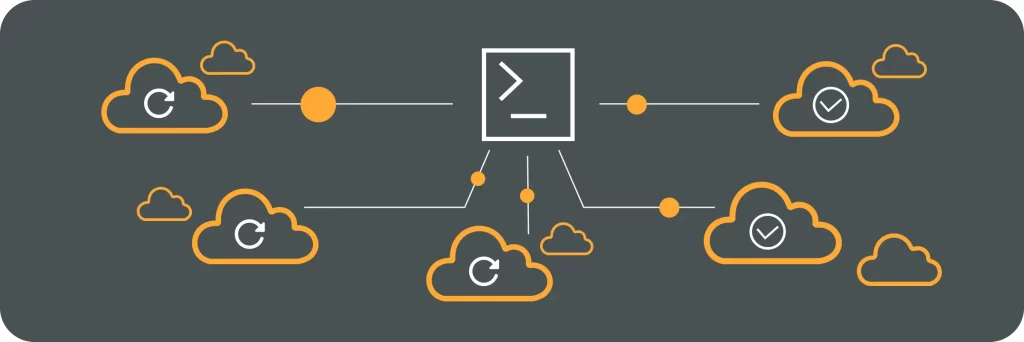In today’s digital landscape, where businesses are constantly seeking ways to enhance efficiency, reduce costs, and improve scalability, the intersection of DevOps and Multi-Cloud has emerged as a powerful combination. This article aims to provide a comprehensive understanding of DevOps and Multi-Cloud, explore their relationship, and discuss the key components, benefits, and challenges of implementing Multi-Cloud DevOps strategies.
Understanding DevOps and Multi-Cloud
The Basics of DevOps
DevOps is a software development methodology that emphasizes collaboration, communication, and integration between development and operations teams. By fostering a culture of continuous improvement and automation, DevOps aims to streamline the software delivery process, enhance product quality, and shorten release cycles.
DevOps is not just a set of practices, but a mindset that encourages cross-functional teams to work together towards a common goal. It encourages developers and operations professionals to break down silos and share responsibilities, enabling faster feedback loops and quicker resolution of issues. This collaboration helps in identifying and addressing potential bottlenecks early on, ensuring a smoother and more efficient software development process.
One of the key principles of DevOps is the use of version control, which allows teams to track changes made to the codebase over time. This not only helps in maintaining a history of the code but also enables multiple developers to work on the same codebase simultaneously, without the fear of conflicts. Version control systems like Git provide a centralized repository for code, making it easier to collaborate and manage changes.
The Concept of Multi-Cloud
Multi-Cloud refers to the use of multiple cloud computing platforms, such as Amazon Web Services (AWS), Microsoft Azure, and Google Cloud Platform (GCP), to meet the varied needs of an organization. It involves distributing workloads and data across different cloud providers, thereby reducing vendor lock-in and increasing redundancy and resilience.
With Multi-Cloud, organizations can choose the best cloud services from different providers based on their specific requirements. For example, they can leverage AWS for its extensive range of services and scalability, while using Azure for its strong integration with Microsoft tools and services. This flexibility allows businesses to optimize costs and avoid vendor dependencies, as they are not tied to a single cloud provider.
Moreover, Multi-Cloud also extends to encompass the use of both private and public clouds. Organizations can leverage the benefits of private clouds, such as enhanced security and control, for sensitive data and critical workloads, while using public clouds for less sensitive workloads that require scalability and cost-effectiveness. This hybrid approach provides businesses with the best of both worlds, allowing them to tailor their infrastructure to their specific needs.
By adopting a Multi-Cloud strategy, organizations can achieve higher levels of availability and resilience. In the event of a service outage or disruption from one cloud provider, workloads can be seamlessly shifted to another provider, ensuring minimal downtime and uninterrupted service for end-users. This redundancy helps businesses mitigate risks and maintain business continuity, even in the face of unforeseen challenges.
The Intersection of DevOps and Multi-Cloud
How DevOps Facilitates Multi-Cloud Deployment
DevOps practices and principles are inherently aligned with the goals of Multi-Cloud deployment. The emphasis on automation and infrastructure as code enables organizations to easily provision, configure, and manage resources across multiple cloud platforms. By treating infrastructure as code, cloud deployments become repeatable, version-controlled, and easily reproducible, reducing the risk of misconfigurations and ensuring consistency.
The Role of Multi-Cloud in DevOps Strategies
Multi-Cloud plays a critical role in enhancing the resilience and flexibility of DevOps strategies. By leveraging multiple cloud providers, organizations can design highly available and fault-tolerant systems that can withstand failures in any single cloud platform. Additionally, Multi-Cloud allows for workload and data portability, enabling seamless scaling and migration between different clouds to accommodate changing business needs.
Furthermore, the intersection of DevOps and Multi-Cloud opens up a world of possibilities for organizations seeking to optimize their infrastructure and maximize their operational efficiency. With Multi-Cloud, organizations can take advantage of the unique features and capabilities offered by different cloud providers, tailoring their infrastructure to meet specific requirements. This flexibility allows for the adoption of best-of-breed solutions, leveraging the strengths of each cloud provider to create a powerful and comprehensive infrastructure.
Moreover, the combination of DevOps and Multi-Cloud enables organizations to achieve greater cost optimization. By leveraging multiple cloud providers, organizations can compare pricing models and select the most cost-effective options for their workloads. This not only helps in reducing operational costs but also provides the opportunity to take advantage of discounts and promotions offered by different cloud providers, further optimizing the overall expenditure.
Key Components of Multi-Cloud DevOps
Infrastructure as Code (IaC)
Infrastructure as Code (IaC) is a fundamental concept in Multi-Cloud DevOps. It involves defining and managing infrastructure resources, such as virtual machines, networks, and storage, using declarative configuration files. By treating infrastructure as code, organizations can automate the provisioning and management of cloud resources, ensuring consistency and reproducibility across multiple cloud platforms.
When it comes to Multi-Cloud DevOps, IaC plays a crucial role in enabling organizations to scale their infrastructure effortlessly. With the ability to define infrastructure resources through code, teams can easily replicate and deploy their environments across different cloud providers. This not only saves time but also reduces the chances of human error that may occur during manual provisioning.
Furthermore, IaC promotes collaboration and version control within development teams. By using configuration files, developers can work together to define and manage infrastructure resources, ensuring that everyone is on the same page. Additionally, version control systems allow teams to track changes made to the infrastructure code, making it easier to roll back to previous versions if needed.
Continuous Integration and Continuous Delivery (CI/CD)
Continuous Integration (CI) and Continuous Delivery (CD) are essential practices in the DevOps toolkit. CI involves integrating code changes into a shared repository regularly, enabling teams to detect and resolve integration issues early on. CD, on the other hand, encompasses automating the release process, from code build and testing to deployment and monitoring. By implementing CI/CD pipelines across multiple clouds, organizations can achieve a consistent, streamlined software delivery process.
With Multi-Cloud DevOps, CI/CD becomes even more powerful as it allows organizations to leverage the benefits of multiple cloud platforms. By integrating code changes from different development teams and automatically building and testing the code, organizations can ensure that their applications are compatible and functional across various cloud environments. This not only improves the quality of the software but also reduces the time and effort required for manual testing and deployment.
In addition, Multi-Cloud DevOps enables organizations to adopt a hybrid approach to CD, where they can deploy their applications to different cloud providers simultaneously. This approach allows organizations to take advantage of the unique features and capabilities offered by each cloud platform, ensuring optimal performance and scalability.
Benefits of Multi-Cloud DevOps
Enhanced Scalability and Flexibility
Multi-Cloud DevOps enables organizations to scale their infrastructure resources dynamically across multiple cloud platforms. By distributing workloads and leveraging the appropriate cloud provider for specific tasks, businesses can achieve optimal resource utilization while maintaining high availability and performance.
Imagine a scenario where a company experiences a sudden surge in website traffic due to a viral marketing campaign. With Multi-Cloud DevOps, the organization can seamlessly scale its infrastructure by utilizing additional cloud resources from different providers. This ensures that the website remains responsive and accessible to users, preventing any potential downtime or performance issues.
Furthermore, Multi-Cloud offers the flexibility to choose the most suitable cloud services for different application requirements. For example, a company might opt for a cloud provider that specializes in machine learning services for its data analytics needs, while relying on another provider for its storage and database requirements. This approach not only avoids vendor lock-in but also enables cost optimization by selecting the most cost-effective cloud services for each specific task.
Improved Disaster Recovery and Risk Management
By adopting Multi-Cloud DevOps, organizations can significantly improve their disaster recovery capabilities. In the unfortunate event of a cloud provider outage or failure, having critical data and workloads replicated across multiple clouds ensures business continuity.
Let’s consider a scenario where a company’s primary cloud provider experiences a major outage, rendering their services temporarily unavailable. With Multi-Cloud DevOps, the organization has a backup plan in place. By leveraging resources from alternate cloud providers, the company can seamlessly redirect its operations to ensure minimal disruption to its customers and users.
Moreover, Multi-Cloud DevOps reduces the risk of data loss and enhances resilience by providing redundant infrastructure across different cloud platforms. By replicating data and workloads in geographically diverse locations, organizations can safeguard against natural disasters, cyberattacks, or any other unforeseen events that may impact the availability and integrity of their data.
As we can see, Multi-Cloud DevOps offers numerous benefits, including enhanced scalability, flexibility, improved disaster recovery capabilities, and better risk management. By leveraging the strengths of multiple cloud providers, organizations can optimize their infrastructure, mitigate risks, and ensure seamless business operations.
Challenges in Implementing Multi-Cloud DevOps
Managing Complexity in Multi-Cloud Environments
Implementing Multi-Cloud DevOps introduces additional complexity in terms of managing and orchestrating resources across multiple cloud platforms. Organizations need to invest in robust automation and orchestration tools to streamline the deployment and management of resources, ensuring consistency and efficient utilization of cloud services. Additionally, teams must acquire the necessary skills and expertise to navigate the intricacies of multiple cloud platforms.
Ensuring Security and Compliance
With multiple cloud platforms involved, ensuring security and compliance becomes a more complex challenge in Multi-Cloud DevOps. Organizations must establish unified security policies and procedures across all clouds, implement strong access controls and encryption mechanisms, and regularly monitor and audit the security posture. Compliance with industry regulations, such as GDPR or HIPAA, becomes more intricate when data traverses different cloud providers, requiring comprehensive governance and risk management frameworks.
Conclusion
In conclusion, the combination of DevOps and Multi-Cloud provides organizations with a powerful approach to enhance efficiency, flexibility, and resilience in today’s fast-paced business environment. By implementing Multi-Cloud DevOps strategies, organizations can leverage the strengths of different cloud platforms, achieve streamlined software delivery, and improve scalability and disaster recovery capabilities. However, it is crucial to address the challenges associated with managing complexity and ensuring security and compliance to fully unlock the benefits of Multi-Cloud DevOps.




